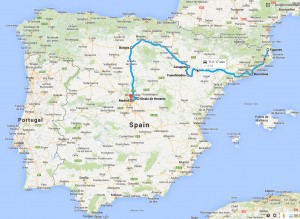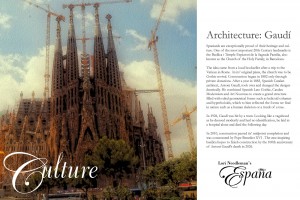An unforgettable journey with Cervantes, Dalí Gaudí, Goya, Picasso and El Cid.
— originally posted for the Huffington Post Travel Next Magazine

For centuries, Spain has been home to some of the world’s greatest artists. Imagine what it would be like to have coffee at a local cafe in Madrid with some of these legends from across time. Perhaps Don Quixote author Miguel de Cervantes would share his memory of being wounded in the Battle of Lepanto and you listen as Antoni Gaudí tells Salvador Dalí and Francisco Goya about how nature influences his architectural designs. Oh, and Picasso pops by with El Cid.
Of course a gathering like this is only a fantasy, but imagine how unforgettable it would be to learn about Spanish literature, art, and culture from the greats who created so many indelible works. Imagine yourself as Sancho Panza, serve as my squire, on a magical journey exploring the glorious country of Spain with the likes of Cervantes, Gaudí, Dalí, Goya, Picasso, and El Cid. Sancho, let´s start chasing windmills in España.
FIGUERES, CATALUÑA
We begin our journey with the illustrious Salvador Dalí in Figueres, which is an hour and a half north of Barcelona. The brilliant and eccentric Surrealist artist is excited to show us the museum he designed and built during the 1960´s. Dalí chose the location of the old theater that had burned down during the Spanish Civil War. Teatro Museo Dalí is a spectacular display of his most celebrated works including sculptures, paintings, optical illusions, mechanical devices, and 3-dimensional collages.
BARCELONA, CATALUÑA
Later, we head to Barcelona because Pablo Picasso has asked us to meet him at Restaurante 7 Portes, located in the same building he first moved to with his family in 1895 from Malága as a child. We have coffee and chat about his first pieces he painted from the rooftop of this building which are now on display at Museu Picasso. The museum is located in five 13th to 15th century Catalan civic gothic palaces that display over 4,200 works from different periods of his life. Soon after his friends, Joan Miró and Antoni Gaudí join us.
The great architect Antoni Gaudí asks if we would like to take a stroll through the breathtaking park he designed, Parc Güell. How could we refuse? He explains the Modernista movement in Spain and how his use of mosaic glass and tile created a wonderful new modern style.

We then saunter over to see his greatest achievement, Basílica de La Sagrada Família. As we gaze up at this masterpiece, he explains how he combined Gothic, Modernism, and Art Nouveau to create this grand structure filled with geometrical forms. They all reflect the forms he found in nature, such as a trunk of a tree or a human skeleton. In awe, we unquestionably understand why Gaudí is considered to be ¨God´s Architect.¨
FUENDETODOS, ARAGÓN
The next day, we make our way to Fuendetodos just outside of Zaragoza. The master painter Francisco Goya has asked us to come to his 18th century farmhouse to see his original etchings at Casa Natal de Goya and Museo del Grabado. He shows us his engraving series called La Tauromaquía (Bull Fights) and Los Desastres de la Guerra (Disasters of War).
ZARAGOZA, ARAGÓN
Goya then takes us on a route in his honor called Paseo de Goya in Zaragoza. First we stop by the Roman Catholic church Basílica del Pilar to see the frescoes he painted on the dome called Regina Martyrum (The Queen of Martyrs) and Adoración del nombre de Dios (Adoration of the Name of God). Then we go to Museo Ibercaja Camón Aznar which has fourteen Goya paintings and five series of prints in this exquisite Renaissance house. Next, we walk over to the Museo de Zaragoza to see the Neoclassical Retrato de Ferdinand VII (Portrait of Ferdinand VII).
BURGOS, CASTILE Y LEÓN
After Zaragoza, we venture to Burgos to meet Rodrigo Díaz de Vivar, El Cid, at the very beginning of a series of routes in his honor called Camino del Cid (Route of El Cid). Later that night, he reads to us from the poem, El Cantar de mio Cid, anonymously written about his journey through Spain during the 11th century as he became an active force in the Reconquest of Spain. With over 1,200 miles to conquer, the official Camino del Cid has been divided into different sections and themes. We decide to take El Destierro (The Exile), the first part of the route from Burgos to Guadalajara, which transports us back to the ancient kingdom of Castile and León as El Cid did to escape the envious King Alfonso VI.
ALCALÁ DE HENARES, COMUNIDAD DE MADRID
At then end of the route in Guadalajara, El Cid brings us down south to the poet and novelist Miguel de Cervantes´ birthplace in Alcalá de Henares. Here we sleep and have mystifying dreams we are 16th century knight-errants tilting at windmills at Museo Casa natal de Cervantes.
MADRID, COMUNIDAD DE MADRID
Rejuvenated, we head to Madrid where Cervantes escorts us to the Museo Nacional del Prado. There he asks us to solve a mystery. Do we think the El Greco painting Retrato de un caballero desconocido (Portrait of an Unknown Gentleman) is him since it was painted during the time Cervantes and El Greco both lived in Toledo, shared common friends, but never met. Where is Sherlock Holmes when you need him?
Afterwards, Cervantes chaperons us to see the sculptures dedicated to him at the Plaza de España. One statue is of him, another is of Don Quixote and Sancho Panza by his side, but his smile is reserved for Don Quixote´s true love, the beautiful Dulcinea del Toboso.
Lucky for us, Picasso happens to be in Madrid as well. He shows us his most significant piece of work at the Museo Nacional Centro de Arte Reina Sofía, Guernica. With heartfelt sympathy, he tells us of the sadness behind his masterpiece and how the bombing of this Basque village, Guernica, during the Spanish Civil War tore out the very core of him.
My dear squire, Sancho, thanks for chasing windmills in Spain. With the likes of these remarkable master artists, there is no doubt that this is why Spain is, and will always be, a hot travel destination in Europe.
To see more images, go to lorineedleman.com. There you will see more images of the beautiful Iberian Peninsula, ESPAÑA.
— Lori Needleman


